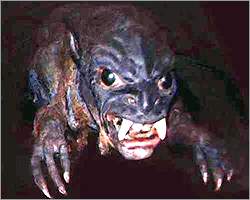-
- SANTIAGO, Chile - Last April,
dozens of farm animals - sheep, pigs, chickens - began turning up dead
in northern Chile, their bodies completely drained of blood and bearing
odd vampire-like bite marks.
-
-

One of the many images of
the Chupacabra floating around the net
-
-
-
- For many Chileans, this could mean only one thing: The
mythical "Chupacabras," or "goat-sucker," Latin America's
version of Count Dracula, was back in the news.
-
- In the northern desert town of Calama, where the "attacks"
first began, locals immediately began to hang crosses in front of their
homes.
-
- Jose Ismael Pino, a farm worker near the central city
of Concepcion, is among the many Chileans who claim to have had an up-close
experience with the Chupacabras.
-
- "It just stood there looking at me," Pino told
local newspaper Cronica. "It stood about four feet tall, like a big
monkey, with long clawed arms, enormous fangs protruding from its mouth,
as well as a pair of wings. "
-
- The Chupacabras legend began in Puerto Rico in 1995,
when eight sheep were found dead with the same telltale signs: bloodless
corpses with bite marks.
-
- Over the next year, reports of attacks multiplied, with
the Chupacabras popping up in Texas, Costa Rica, Mexico, Guatemala and
Brazil. A cultlike " and no doubt profitable " industry has formed
around the Chupacabras in Latin America, spawning T-shirts, bumper-stickers,
squeaky toys, candies, sandwiches and songs.
-
-

-
- Believed at one time to be the remains
of a Chupacabra. Never verified.
-
-
- The myth lost steam after 1996, only to resurface a few
months ago in western Nicaragua, northern Mexico and northern Chile.
-
- Since the first attacks in Calama last spring, well over
800 animals of all kinds have been killed in similar incidents in just
about every region of Chile.
-
- The monster has been variously described as a large rodent
or a mutant kangaroo, while others claim it is a winged, ape-like being
that walks in a zig-zag pattern.
-
- Lilliana Romero, a school teacher in Concepcion, Chile,
told the local newspaper that she woke up in the middle of the night and
saw a Chupacabras.
-
- "I crouched and looked through the window,"
she told El Sur. "I could see the back of what appeared to be an immense
man, standing more than two meters [6 feet, 8 inches] tall. The shoulder
blades were split, as if he had wings." The next day, Romero said,
she found a completely bloodless dog dead in the alleyway behind her house.
-
-

-
-
- Another wave of hysteria swept Chile in May when rumors
spread that three Chupacabras - a male, a female and a cub - were captured
by Chilean soldiers near a mine north of Calama. Some locals even claimed
that a team of NASA scientists arrived in a black helicopter and took them
away.
-

The most recent purported Chupacabra remains
-
-
- The popular rumor in Calama these days is that the Chupacabras
escaped from a secret NASA experiment in the Atacama Desert of northern
Chile, where they say the space agency is trying to replicate the conditions
of a voyage to the planet Mars.
-
- As for Chilean authorities, they have steadfastly maintained
that most of the attacks were caused by packs of feral dogs.
-
- The Chupacabras legend is beginning to take root in Chile
for good, said Bernardo Valenzuela, an anthropology professor at the University
of Chile.
-
- "These animals, whatever they are, just suck the
blood of their victims, without eating their meat - no wonder the popular
imagination has generated this legend," Valenzuela told FOXNews.com.
-
- Fear of the night and fascination with werewolves may
have also played a key role in the popularity of the Chupacabras myth,
anthropologists say.
-
-
- The Chupacabras' existence has never been scientifically
proven; skeletal cadavers and decomposing remains have been proudly produced
by farmers from time to time but have ended up identified as dead dogs
or bats.
-
- But in the meantime, the Latin Goat-Sucker continues
to inspire the public's imagination, and its legend grows in the Chilean
countryside - as well as in thousands of Web pages.

-
- MainPage
http://www.rense.com
-
-
-
- This
Site Served by TheHostPros
|